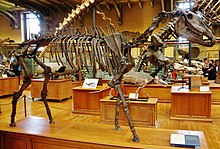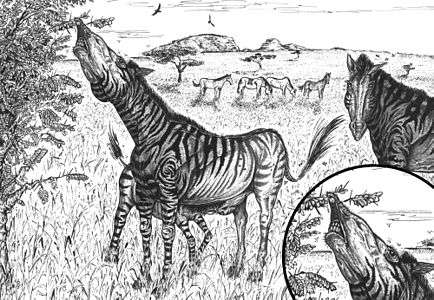Hippidion
Hippidion (meaning little horse) is an extinct genus of horse that lived in South America from the Late Pliocene to the end of the Late Pleistocene (Lujanian), between two million and 11,000 years ago. They were one of two lineages of equines native to South America during the Pleistocene epoch alongside those of the Equus subgenus Amerhippus.

| Hippidion | |
|---|---|
| H. principale skeleton | |
| Scientific classification | |
| Kingdom: | Animalia |
| Phylum: | Chordata |
| Class: | Mammalia |
| Order: | Perissodactyla |
| Family: | Equidae |
| Subfamily: | Equinae |
| Tribe: | Equini |
| Genus: | †Hippidion Owen, 1869 |
| Species | |
| |
| Synonyms | |
Evolution

Hippidion has been considered a descendant of pliohippines,[1] horses that migrated into the South American continent around 2.5 million years ago.[1][2] Early analysis of the ancient DNA of Hippidion and other New World Pleistocene horses supported the novel hypothesis that Hippidion was actually a member of the living genus Equus, with a particularly close relationship to the wild horse, Equus ferus.[1][2] However this was later shown to be incorrect, with more complete sequences finding Hippidion as an outgroup to all living equines[3] and less closely related to living horses than the "New World stilt legged horse", Haringtonhippus francisci.[4]
Hippidion is traditionally thought to have 3 species, H. principale, H. saldiasi and H. devillei, however, in the DNA analysis, the single sampled H. principale specimen was found to be nested with H. saldiasi, with H. devillei found to be clearly genetically distinct.[3]
Hippidion and other South American horses became extinct approximately 8,000 years ago.[5] Specific archaeological recovery at the Cueva del Milodon site in Patagonian Chile demonstrates that Hippidion saldiasi existed in that vicinity in the era of 10,000 to 12,000 years before present.[6] Horses did not reappear in South America until the 16th century, as a result of introduction by humans.
Description
It stood approximately 1.4 metres (4.6 ft) (also 13.2 hh) high at the shoulders and resembled a donkey. The skull of Hippidion is noted for its nasal bone, which projects forward from the skull.[7]
Diet and Ecology

A study found that Late Pleistocene specimens of Hippidion had lower δ13C values than those of specimens of Amerihippus, indicating a preference for C3 woodland and wooded open habitats.[7]
Discovery
Remains of Hippidion saldiasi have been recovered in locations such as the Piedra Museo site, Santa Cruz, Argentina[8] and Cueva del Milodon, Chile.[9] The significance of such archaeological recovery is amplified by the association with hunting of these animals by prehistoric man at possible Pre-Clovis horizons.
Extinction
Hippidion became extinct alongside the other South American equines at the end of the Late Pleistocene, between 15,000 and 10,000 years ago as part of the Quaternary extinction event, which resulted in the extinction of most large animals in both North and South America. Climactic modelling suggests that the preferred habitat for species of Hippidion declined after the Holocene transition, but the decline isn't enough to explain the extinction.[11]
References
- Weinstock, J.; et al. (2005). "Evolution, systematics, and phylogeography of Pleistocene horses in the New World: a molecular perspective". PLoS Biology. 3 (8): e241. doi:10.1371/journal.pbio.0030241. PMC 1159165. PMID 15974804.
- Orlando, L.; et al. (2008). "Ancient DNA Clarifies the Evolutionary History of American Late Pleistocene Equids". Journal of Molecular Evolution. 66 (5): 533–538. doi:10.1007/s00239-008-9100-x. PMID 18398561.
- Der Sarkissian, Clio; Vilstrup, Julia T.; Schubert, Mikkel; Seguin-Orlando, Andaine; Eme, David; Weinstock, Jacobo; Alberdi, Maria Teresa; Martin, Fabiana; Lopez, Patricio M.; Prado, Jose L.; Prieto, Alfredo (March 2015). "Mitochondrial genomes reveal the extinct Hippidion as an outgroup to all living equids". Biology Letters. 11 (3): 20141058. doi:10.1098/rsbl.2014.1058. ISSN 1744-9561. PMC 4387498. PMID 25762573.
- Heintzman, P.D.; Zazula, G.D.; MacPhee, R.D.E; Scott, E.; Cahill, J.A.; McHorse, B.K.; Kapp, J.D.; Stiller, M.; Wooller, M.J.; Orlando, L.; Southon, J.; Froese, D.G.; Shapiro, B. (2017). "A new genus of horse from Pleistocene North America". eLife. 6. doi:10.7554/eLife.29944. PMC 5705217. PMID 29182148.
- Ransom, Jason I.; Kaczensky, Petra (2016-05-15). Wild Equids: Ecology, Management, and Conservation. JHU Press. ISBN 9781421419107.
- C. Michael Hogan, Cueva del Milodon, Megalithic Portal, 13 April 2008
- Prado, José Luis; Alberdi, María Teresa (2017-04-25). Fossil Horses of South America: Phylogeny, Systemics and Ecology. Springer. ISBN 9783319558776.
- Alberdia, María T.; Miottib, Laura; Pradoc, José L. (2001). "Hippidion saldiasi Roth, 1899 (Equidae, Perissodactyla), at the Piedra Museo Site (Santa Cruz, Argentina): Its Implication for the Regional Economy and Environmental Reconstruction". Journal of Archaeological Science. 28 (4): 411–419. doi:10.1006/jasc.2000.0647.
- "The Megalithic Portal and Megalith Map: Cueva del Milodon Cave or Rock Shelter". Retrieved 2008-12-08.
- Hippidion at Fossilworks.org
- Villavicencio, Natalia A.; Corcoran, Derek; Marquet, Pablo A. (2019-06-27). "Assessing the Causes Behind the Late Quaternary Extinction of Horses in South America Using Species Distribution Models". Frontiers in Ecology and Evolution. 7: 226. doi:10.3389/fevo.2019.00226. ISSN 2296-701X.